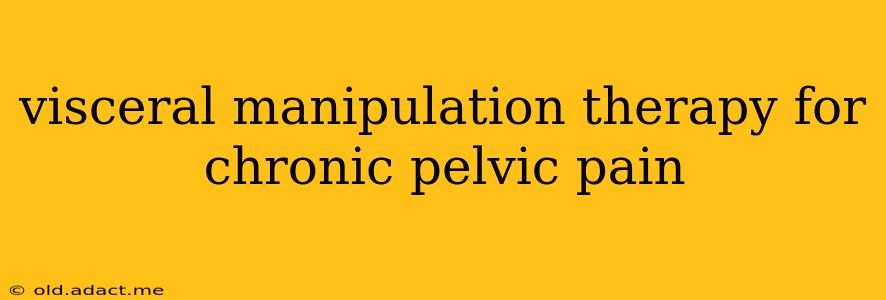Chronic pelvic pain (CPP) is a debilitating condition affecting millions, significantly impacting quality of life. While numerous treatment options exist, visceral manipulation therapy (VMT) offers a holistic approach gaining increasing recognition for its potential in managing CPP. This comprehensive guide explores VMT's role in addressing CPP, addressing common questions and concerns.
What is Visceral Manipulation Therapy (VMT)?
Visceral manipulation is a gentle, hands-on therapy focusing on the internal organs (viscera) and their relationship with the surrounding structures like muscles, ligaments, and fascia. Unlike other therapies that might focus solely on musculoskeletal issues, VMT acknowledges the interconnectedness of the body and addresses restrictions or mobility limitations within the visceral system. These restrictions can stem from past surgeries, injuries, infections, or even stress, leading to pain and dysfunction. A skilled VMT practitioner uses specific techniques to restore optimal mobility and function to the internal organs, thereby relieving pain and improving overall health.
How Does VMT Help with Chronic Pelvic Pain?
Chronic pelvic pain often involves multiple contributing factors, including muscular tension, nerve irritation, and organ dysfunction. VMT addresses these factors by:
- Improving organ mobility: Restricted organs can pull on surrounding tissues, causing pain. VMT gently releases these restrictions, improving organ movement and reducing strain.
- Reducing fascial restrictions: The fascia, a connective tissue that surrounds and supports organs, can become tight and restricted, contributing to pain. VMT helps release these fascial restrictions, improving tissue elasticity and reducing pain.
- Improving lymphatic drainage: VMT can stimulate lymphatic flow, aiding in the removal of waste products and reducing inflammation, both crucial aspects in managing chronic pain.
- Reducing nerve irritation: By addressing organ restrictions and fascial tensions, VMT indirectly reduces pressure on nerves, thus alleviating nerve-related pain.
- Addressing adhesions: Post-surgical adhesions (scar tissue) can restrict organ movement and cause pain. VMT techniques can help to gently break down these adhesions, improving mobility.
What are the Benefits of VMT for Chronic Pelvic Pain?
Many patients report significant improvements in pain levels, reduced need for medication, and improved overall quality of life following VMT treatment. Specific benefits may include:
- Pain reduction: Many experience a noticeable decrease in pelvic pain intensity.
- Improved bowel and bladder function: VMT can address functional issues related to bowel and bladder control.
- Reduced inflammation: Improved lymphatic drainage can help reduce inflammation contributing to pain.
- Increased mobility: Improved organ mobility and reduced fascial restrictions can improve overall mobility.
- Improved quality of life: By addressing pain and related functional issues, VMT can lead to a significant improvement in overall well-being.
Is VMT Safe for Chronic Pelvic Pain?
VMT is generally considered safe when performed by a qualified and experienced practitioner. However, as with any manual therapy, there are potential risks, including temporary soreness or discomfort. It's crucial to choose a practitioner with appropriate training and experience in treating pelvic pain. A thorough medical evaluation should be conducted before initiating VMT, especially in patients with underlying health conditions.
What are the Side Effects of VMT?
Side effects are generally minimal and temporary. Some individuals may experience mild soreness or fatigue following a session, but these usually subside quickly. Serious side effects are rare. However, if you experience any concerning symptoms, it's vital to contact your practitioner.
How Many Sessions of VMT are Needed for Chronic Pelvic Pain?
The number of sessions required varies depending on the individual's condition, the severity of the pain, and the response to treatment. Some may experience relief after a few sessions, while others may require a more extensive course of treatment. Your practitioner will develop a personalized treatment plan based on your specific needs.
What is the Difference Between VMT and Other Pelvic Pain Treatments?
VMT differs from other therapies by focusing specifically on the internal organs and their relationship with the surrounding structures. While other therapies may address muscular or neurological components of pelvic pain, VMT offers a unique approach by addressing the visceral component. It is often used in conjunction with other therapies for a more comprehensive approach to pain management.
How Do I Find a Qualified Visceral Manipulation Therapist?
Finding a qualified practitioner is crucial. Look for therapists certified by reputable organizations specializing in visceral manipulation. Ask about their experience treating chronic pelvic pain and check for references or testimonials.
Disclaimer: This information is for educational purposes only and should not be considered medical advice. Always consult with a healthcare professional before starting any new treatment, including visceral manipulation therapy. The effectiveness of VMT for chronic pelvic pain can vary from person to person.
